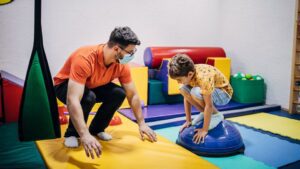I am a sensory integration assessment teacher, and each year, I evaluate sensory integration for over 100 children. Most of these children have developmental disorders such as autism, cerebral palsy, intellectual disabilities, language impairments, ADHD, and developmental delays. Many of them exhibit sensory integration dysfunction symptoms.
However, most typically developing children do not experience sensory integration dysfunction. If someone claims that your child has sensory integration issues after just a few classes, their main goal might be to sell you their training programs.

What is Sensory Integration?
Sensory integration is a concept introduced by Dr. Ayres from the University of California in 1972. He divided the senses into seven types: visual, auditory, olfactory, gustatory, tactile, vestibular, and proprioceptive. Sensory integration refers to how we process sensory information and respond to it appropriately.
For example, if you see a ball flying toward you, your brain processes this visual information, and your body reacts to avoid being hit. This process of perceiving and reacting to external stimuli is sensory integration.
Sensory Integration Dysfunction includes:
- Sensory Input Issues (e.g., unable to see the ball)
- Processing Issues (e.g., seeing the ball but not knowing what to do)
- Sensory Output Issues (e.g., knowing the ball is coming but being too slow or clumsy to avoid it)
Typically developing children rarely have sensory integration dysfunction, but children with developmental disorders often do. For example:
- Children with ADHD often have attention issues and may miss seeing the ball coming.
- Children with autism may see the ball but may not know how to respond.
- Children with cerebral palsy or intellectual disabilities may understand the ball is coming but lack the coordination to avoid it.
How Does Sensory Integration Relate to Cognitive Development?
Sensory integration plays a crucial role in cognitive development, forming the foundation of children’s intelligence. Jean Piaget’s cognitive development theory is divided into four stages:
- Sensorimotor Stage (0-2 years): Development from external behavior to internal mental traits.
- Preoperational Stage (2-7 years): The stage of using symbolic thinking, language, and imaginative play.
- Concrete Operational Stage (7-11 years): Development of logical thinking and problem-solving with concrete objects.
- Formal Operational Stage (11 years and up): The ability to think abstractly.
Piaget’s theory reveals that children view the world differently from adults. For example, before the age of 1, babies lack self-awareness and cannot connect impressions over time. A child’s understanding of object permanence (the idea that objects continue to exist even when unseen) develops as sensory motor skills mature.
How Does Sensory Integration Affect Everyday Life for Children?
Sensory Integration Dysfunction can affect various aspects of a child’s life:
- Self-care Skills: Children may have difficulty with tasks like dressing, feeding themselves, or avoiding accidents.
- Learning and Attention: Children may struggle with sitting still, focusing, reading, writing, or speaking clearly.
- Social Interaction and Emotions: Children may have difficulty managing their emotions, socializing, or may have low self-esteem.
Types of Sensory Integration Dysfunction:
- Sensory Response Dysfunction
- Vestibular Over-Sensitivity: Fear of heights, spinning objects, loud noises, or bright lights.
- Vestibular Under-Sensitivity: Difficulty perceiving motion or sound, leading to balance issues.
- Vestibular Seeking: Engaging in repetitive motions like spinning, running, or self-talk.
- Proprioceptive Dysfunction
- Low Proprioceptive Response: The child is unaware of body position, leading to slow or clumsy movements.
- Proprioceptive Seeking: Children may seek constant physical contact, like crashing into objects, chewing on toys, or falling intentionally.
- Tactile Dysfunction
- Tactile Over-Sensitivity: The child may resist physical contact or be afraid of certain textures (like clothing or food).
- Tactile Under-Sensitivity: The child may not feel pain or touch and may ignore physical discomfort.
- Tactile Seeking: The child may excessively touch objects or put things in their mouth for sensory feedback.

Can Sensory Integration Training Benefit Typically Developing Children?
Is sensory integration training useful for typically developing children?
Yes, sensory integration training can benefit all children. It is not just for children with dysfunction but helps children develop their ability to explore and understand the world. Sensory integration is a foundation for learning, helping children refine their coordination, balance, and attention.
Characteristics of Sensory Integration Therapy:
- Child-Led: The child takes the lead in activities.
- Encouraging Independent Learning: The child explores and learns from experiences.
- Fun and Flexible: The therapy uses engaging games to keep children interested.
- Motivating: The activities tap into a child’s internal drive and curiosity.
- Adaptable: The activities are designed to suit the child’s individual needs.
Be Cautious When Choosing Sensory Integration Programs
The market is full of sensory integration programs, and not all of them are legitimate. I would advise parents of typically developing children to be cautious when selecting programs, as many programs are designed to sell more services. If you are interested in sensory integration, you may want to learn about these techniques yourself. Sensory integration can also be implemented as a series of enjoyable parent-child activities at home.

Key Points to Remember
- Sensory integration helps children process sensory information and respond appropriately.
- It is particularly helpful for children with developmental disorders like autism, ADHD, and cerebral palsy.
- Even typically developing children can benefit from sensory integration training, as it supports overall development and cognitive growth.
- Sensory integration therapy should be child-led, fun, and tailored to individual needs.




